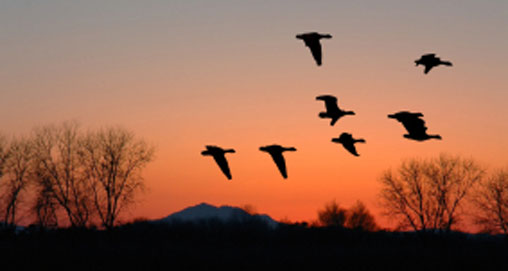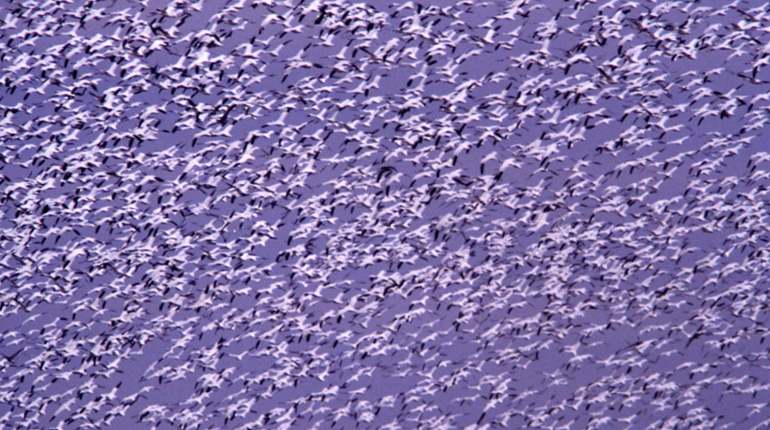
1.) Don't Change Tactics
When what you're doing isn't working, change. I spend much of each season hunting with average-Joe hunters, not pro staffers and guides. And if there's anything more frustrating than ducks or geese flaring off our spread all morning with no one attempting to remedy the problem, I haven't lived through it yet. I don't mean to sound like an ingrate, but there you have it.If, by landing elsewhere, the birds are telling you you've set up in the wrong spot, move.
2.) Don't Hide Your Blind Well Enough
Hunt with an expert field hunter and you'll learn what he considers to be the critical element for success: hiding the blinds. You'll realize this before he even steps out of the truck, when he tests the wind, then sweeps the headlights back and forth through the pitch black as he looks for low spots that'll help shade the layout blinds once the sun rises.
Even low-profile blinds will cast unnatural geometric shadows once direct sunlight hits them, so you want to use every contour to your advantage.
3.) Don't Take the Time to Scout
I can think of all sorts of reasons why I don't have time to scout duck holes. But when I show up to find few to no birds flying overhead, or when flock after flock lands 200 yards away, I only have myself to blame. Frankly, some places I hunt are far enough away that I won't waste time and gas scouting the afternoon before. So I accept what I get in return. But when I forego scouting a closer location because I am simply too lazy, well, that's another matter.
4.) Haphazardly Set Your Decoys
Whenever I see two tightly spaced pods of decoys with a clearly defined gap between them, I'm amazed any ducks come in. Evidently, enough do to keep some hunters using that setup day after day, but it's not a good way to kill limits consistently. No doubt the age-old J-hook and U-shaped patterns can still fool waterfowl under certain conditions or for certain species, but any hunter who automatically knows how he's going to set his spread in advance is setting himself up for failure.
5.) Overcall
Some days you have to call aggressively to bring in flocks; on others you might make one noise and spook a flock. It all depends on how the birds react, but one rule is usually a constant: If you sound like a broken record, you're calling too much (or, at the very least, haven't learned enough different sounds to call effectively).
6.) Ignore Your Gear
Most hunters don't spend enough time preparing their gear prior to each season. Dirty decoys, tangled cords, layout blinds full of dirt and spent hulls, dirty shotguns, parkas and waders and gloves scattered between houses and garages can all ruin a hunt if they're not in good working order and ready to go. Don't be lazy; take care of your gear and dog before the season opener.
7.) Don't Test Your Shotgun and Loads
Most hunters buy whatever loads are cheapest, then head to the blind without ever testing them. Fact is, all shotshells are not created equal, and not only do some shotguns not shoot where they're pointed, shooting different ammo through the same one will produce widely varying results. Ideally, you should practice with your hunting loads prior to the season and, better yet, pattern them.
8.) Call Shots Badly
Knowing when to call shots isn't always easy. A strong backwind makes it imperative to get flocks as close as possible if you plan to get off more than one good round. Conversely, waiting too long on calmer days often results in birds that are too close for shot patterns to open up. Almost as bad: People who give the command to shoot when birds are on one side of a line of shooters.
9.) Heed advice that begins with "Always" and "Never"
This is Bill Cooksey's favorite faux pas: Taking advice that includes the words "never" and "always." Because almost every rule in waterfowling has exceptions, whenever a hunter utters these words it's almost a sure bet he doesn't know what he's talking about. Most hunters don't fall into bad habits by themselves; they usually learn them from people they assume know what they're talking about, but don't.
10.) Wear the Wrong Camo
As a photographer, I'm constantly amazed how many hunters wear camo that doesn't remotely match the environment in which they're hunting. A classic case is marsh or field hunters wearing Mossy Oak Break-Up, or timber hunters wearing Realtree Wetlands. Either they look like black blobs in light-brown cattails or like light-brown blobs among gray trees and black water.




































